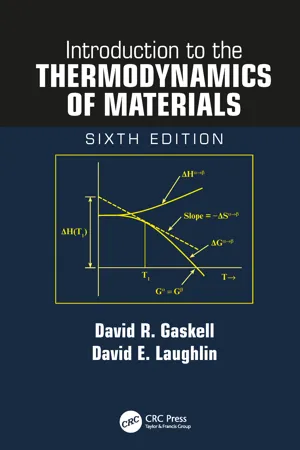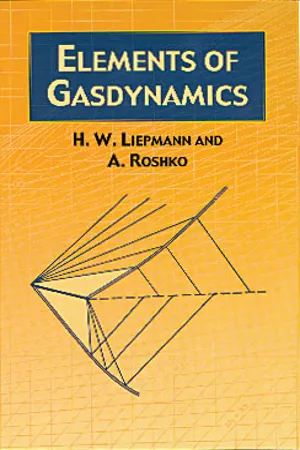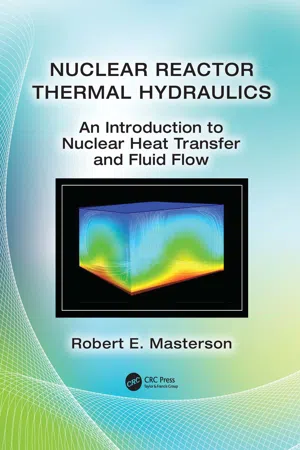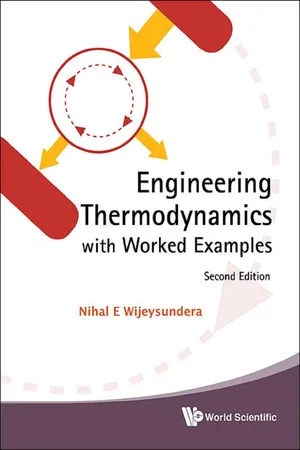Technology & Engineering
Thermodynamic Variables
Thermodynamic variables are properties that describe the state of a system, such as temperature, pressure, and volume. These variables are used to quantify and analyze the behavior of energy and matter within a system. Understanding and manipulating thermodynamic variables is crucial in the design and operation of various engineering systems, including power plants, refrigeration systems, and chemical processes.
Written by Perlego with AI-assistance
Related key terms
Related key terms
1 of 4
Related key terms
1 of 3
6 Key excerpts on "Thermodynamic Variables"
- eBook - ePub
- Howard Reiss(Author)
- 2012(Publication Date)
- Dover Publications(Publisher)
Another source of confusion which may arise in connection with the above definition concerns the reproducibility of the equilibrium state. Once it has been ascertained that the properties of the system are not changing with time and that a steady state is not involved, it may still be impractical to treat the system by the methods of thermodynamics. Before thermodynamics can be applied effectively, the experimenter must be able to reproduce the state at will. To accomplish this, he must know what variables determine the state; and even more important, he must be able to control these variables. As an example, a solid may be prepared in many states which meet the requirement of invariance to time (at least during the time of a measurement). But each of these states may be complicated by the fact that the solid contains an array of internal strains. To each distinct set of strains will correspond (under our definition) another state of equilibrium. The strains themselves are variables of the system, and unless we can control them and reproduce them, it will not be practical to employ the methods of thermodynamics.4. Thermodynamic State, Variables of State
We are now in a position to define a thermodynamic state, a term which, unless otherwise specified, will be restricted to the description of systems at equilibrium. If the thermodynamic properties of a system at equilibrium are observed, it will be noted that whenever a certain number of them assumes certain numerical values all the remaining properties take on perfectly definite values. For example, in the case of a substance like water, whenever a given mass1 has a certain temperature and pressure, the volume of that mass will be determined in the sense that whenever the values of temperature and pressure are reproduced so will be the value of its volume. Alternatively, whenever the temperature and volume assume certain values, the pressure will be perfectly well defined. In order for all the properties to be reproduced, it is only necessary that the same number of them be reproduced. This number is called the degrees of freedom , or the number of independent variables of the system. A thermodynamic state is then defined in terms of the independent variables, each set of values for the independent variables corresponding to a state. For a macroscopic system, the number of independent Thermodynamic Variables is usually small. By contrast, if it were necessary to describe the microscopic state of some thermodynamic system, say a mole of water, it would be necessary to specify the values of the coordinates of position and momentum for all the elementary particles constituting that mole. Thus, the number of independent microscopic variables might be as high as 1024 or 1025 - eBook - ePub
- David R. Gaskell, David E. Laughlin(Authors)
- 2017(Publication Date)
- CRC Press(Publisher)
postulate . There are situations, however, when more independent variables are needed—for example, when thermodynamic fields other than temperature and pressure are present. Such fields include electric or magnetic fields.The values of the Thermodynamic Variables of a system are not functions of the history of the system; that is, they are independent of the path over which the process has taken the system in changing it from its previous state to its present state. These Thermodynamic Variables are thus intrinsic to the state of the system. Such Thermodynamic Variables are functions of state and can be expressed as exact differentials†of their dependent variables. There are, of course, times when the system has properties which do depend on its history; these properties are commonly called extrinsic properties. They are not equilibrium properties of the system; given time, they may change. It should be noted that some of these extrinsic properties can be manipulated to produce materials with optimum characteristics.Consider the volume, V , of 1 mole of a pure gas. The value of the volume is dependent on the values of the pressure, P , and temperature, T , of the gas. The relationship between the dependent variable V and the independent variables P and T can be expressed asV = V ( P , T )(1.1) In a three-dimensional diagram, the coordinates of which are volume, pressure, and temperature, the points in V -P -T space which represent the equilibrium states of existence of the system lie on a surface. This is shown in Figure 1.1 - eBook - ePub
- Michael J. Moran, Howard N. Shapiro, Daisie D. Boettner, Margaret B. Bailey(Authors)
- 2018(Publication Date)
- Wiley(Publisher)
CHAPTER 1 Readings
Medical professionals rely on measurements of pressure and temperature, introduced in Secs. 1.6 and 1.7 .Engineering Context
Although aspects of thermodynamics have been studied since ancient times, the formal study of thermodynamics began in the early nineteenth century through consideration of the capacity of hot objects to produce work. Today the scope is much larger. Thermodynamics now provides essential concepts and methods for addressing critical twenty-first-century issues, such as using fossil fuels more effectively, fostering renewable energy technologies, and developing more fuel-efficient means of transportation. Also critical are the related issues of greenhouse gas emissions and air and water pollution.Thermodynamics is both a branch of science and an engineering specialty. The scientist is normally interested in gaining a fundamental understanding of the physical and chemical behavior of fixed quantities of matter at rest and uses the principles of thermodynamics to relate the properties of matter. Engineers are generally interested in studying systems and how they interact with their surroundings. To facilitate this, thermodynamics has been extended to the study of systems through which matter flows, including bioengineering and biomedical systems.The objective - eBook - ePub
- H. W. Liepmann, A. Roshko, A. Roshko(Authors)
- 2013(Publication Date)
- Dover Publications(Publisher)
θ can be measured, and in equilibrium do not depend upon time.Variables that depend only upon the state of the system are called variables of state, p and V are evidently such variables, and these two are already familiar from mechanics. For a complete thermodynamic description of a system, we need new variables of state, foreign to mechanics. Thus it is a result of experience that the pressure of a system is not only a function of its volume. A new variable of state, θ , the temperature, has to be introduced. For a simple system,Following R. H. Fowler, one states the “zeroth law of thermodynamics”:There exists a variable of state, the temperature θ . Two systems that are in thermal contact, i.e., separated by an enclosure that transmits heat, are in equilibrium only if θ is the same in both.Consequently, with the help of Eq. 1.1 , we can use the pressure and the volume of an arbitrary system as a thermometer.When we discuss the exchange of work or heat between a system and its surroundings, we find the need for a variable of state E , the internal energy, which measures the energy stored in the system. The first law of thermodynamics introduces E , as will be seen later.Furthermore we shall find it necessary to introduce a variable of state S , the entropy, which, for example, is needed to decide whether a state is in stable equilibrium. The second law of thermodynamics introduces S and defines its properties.For a simple system E and S are functions of p , V , θ . But, since p can be expressed by V and θ , using Eq. 1.1 , it is sufficient to write:Relations like Eqs. 1.1 , 1.2 , and 1.3 are called equations of state . Specifically Eq. 1.1 is called the “thermal equation of state”; Eq. 1.2 - eBook - ePub
Nuclear Reactor Thermal Hydraulics
An Introduction to Nuclear Heat Transfer and Fluid Flow
- Robert E. Masterson(Author)
- 2019(Publication Date)
- CRC Press(Publisher)
7Thermodynamic Properties and Equations of State
7.1 Thermodynamic Properties and Nuclear Power Plants
Nuclear reactors rely on the laws of thermodynamics to function properly, and nuclear power plants rely on these same laws to convert thermal energy into electric power. (see Figure 7.1 ). Many of the thermodynamic properties used in the design of nuclear power plants can be deduced from what are known as thermodynamic state variables . Examples of these state variables are the temperature, the pressure, the volume, and the entropy. Sometimes the internal energy and the enthalpy are also considered to be state variables, but they are usually considered to be thermodynamic properties because they can be derived from other state variables. The purpose of this chapter is to discuss the thermodynamic properties of reactor coolants and show how their thermodynamic properties are related to these state variables. In particular, we would like to discuss the difference between a reactor coolant when it is a liquid and when it is a vapor. The thermodynamic properties of water and steam are tabulated in a set of famous thermodynamic property tables called the steam tables . The steam tables are presented in Appendix G . Normally, the steam tables are applied to reactors where hot water and steam are mixed together to generate electric power. State variables such as the temperature and the pressure can also be used to determine the thermodynamic efficiency of a nuclear power plant. As we pointed out in Chapter 6 , any increase in the thermodynamic efficiency allows more work to be performed from the same amount of heat. In other words, a reactor can be thought of as large thermonuclear furnace in which copious amounts of thermal energy are produced. The temperature and the pressure of the core and the thermodynamic properties of the coolant determine how efficiently this heat can be converted into electric energy. The most common reactor coolant is water (which can be either light or heavy), although other coolants such as liquid metals, hydrogen, helium, and carbon dioxide can also be used (see Chapter 1 - eBook - ePub
- Nihal E Wijeysundera(Author)
- 2016(Publication Date)
- WSPC(Publisher)
Chapter 1
Thermodynamic Systems and Properties
In this chapter we shall introduce some of the important concepts and definitions that provide the basic framework for the study of engineering thermodynamics. The logical development and generalization of the first and second laws of thermodynamics in later chapters of the book rely on these concepts and definitions.1.1Thermodynamics
Thermodynamics deals with energy and matter, their transformations and the interactions between them. Since all engineering systems involve energy and matter, the applications of thermodynamics are very broad. Mechanical and chemical engineering are two of the traditional branches of engineering where applications of thermodynamics abound. Although the laws of thermodynamics are universally valid, their presentation and the mode of development could vary according to the engineering discipline.1.2Systems and Surroundings
For the analysis of physical situations involving matter and energy, it is useful to isolate regions or entities on which attention may be focused with a view to applying the laws of thermodynamics. These regions or entities are called thermodynamic systems . A real or imaginary boundary is drawn to physically demarcate and clearly identify the system. The boundary may be fixed or deformable. Everything that lies outside the boundary constitutes the surroundings . Systems can be further categorized based on the type of matter and energy interactions between them and their surroundings. These interactions occur across the boundary.1.2.1Closed-system or control-mass
A system where there is no matter transfer across the boundary is called a closed-system or a control-mass . Note, however, that energy interactions may occur across the boundary.1.2.2Open-system or control-volume
For an open-system or control-volume
Index pages curate the most relevant extracts from our library of academic textbooks. They’ve been created using an in-house natural language model (NLM), each adding context and meaning to key research topics.
Explore more topic indexes
Explore more topic indexes
1 of 6
Explore more topic indexes
1 of 4





